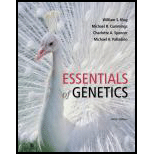
Concept explainers
What is VNTR profiling, and what are the applications of this technique?
To review:
VNTR (Variable number tandem repeat) profiling and its applications.
Introduction:
All cells of an organism have genetic material mostly in the form of DNA (deoxyribonucleic acid). The basic chemical structure of the DNA molecule between different species of organisms remains the same but the sequence of the nitrogenous bases differs. On the other hand, in individuals of the same species, the basic sequence remains conserved, only some repeat sequences in the DNA molecules differ in length depending upon how many times the particular sequence is tandemly repeated.
Explanation of Solution
VNTR is a specific genome location, where there are tandem repeats of short nucleotide sequences (10-100 base pairs long). These tandem repeats vary in length amongst different individuals. These VNTR sequences are inherited by the offspring from their parents as they are parts of the DNA sequences.
DNA typing or DNA profiling is a technique that distinguishes between the individuals belonging to the same species using DNA samples from blood, hair, or other tissues. The DNA sequences, if checked for VNTR sequences then it is known as VNTR profiling.
The VNTR sequences differ in length in different individuals and are flanked by restriction endonuclease sites. Upon action of the restriction enzymes on these sequences, different DNA segments are yielded, which in turn give different RFLP (restriction fragment length polymorphism) patterns.
A VNTR profile is created by first digesting the VNTR repeat region on the DNA with the help of restriction enzymes, separating the cleaved VNTR segments using gel electrophoresis, followed by Southern blotting. The DNA segments blotted on the membrane are thus hybridized with a probe for identification. These DNA segments can, therefore, be used for forensic studies to find missing people, to determine the parent of a child, and to establish whether a person is a criminal or not.
Thus, it can be concluded that VNTR profiling is a technique of DNA typing, which utilizes VNTR segments to distinguish between individuals of the same species. This technique is involved in forensic studies to determine a child’s parents, in determining criminals, and also to find missing people.
Want to see more full solutions like this?
Chapter CHST3 Solutions
Essentials of Genetics (9th Edition) - Standalone book
- Describe the principle of homeostasis.arrow_forwardExplain how the hormones of the glands listed below travel around the body to target organs and tissues : Pituitary gland Hypothalamus Thyroid Parathyroid Adrenal Pineal Pancreas(islets of langerhans) Gonads (testes and ovaries) Placentaarrow_forwardWhat are the functions of the hormones produced in the glands listed below: Pituitary gland Hypothalamus Thyroid Parathyroid Adrenal Pineal Pancreas(islets of langerhans) Gonads (testes and ovaries) Placentaarrow_forward
- Describe the hormones produced in the glands listed below: Pituitary gland Hypothalamus Thyroid Parathyroid Adrenal Pineal Pancreas(islets of langerhans) Gonads (testes and ovaries) Placentaarrow_forwardPlease help me calculate drug dosage from the following information: Patient weight: 35 pounds, so 15.9 kilograms (got this by dividing 35 pounds by 2.2 kilograms) Drug dose: 0.05mg/kg Drug concentration: 2mg/mLarrow_forwardA 25-year-old woman presents to the emergency department with a 2-day history of fever, chills, severe headache, and confusion. She recently returned from a trip to sub-Saharan Africa, where she did not take malaria prophylaxis. On examination, she is febrile (39.8°C/103.6°F) and hypotensive. Laboratory studies reveal hemoglobin of 8.0 g/dL, platelet count of 50,000/μL, and evidence of hemoglobinuria. A peripheral blood smear shows ring forms and banana-shaped gametocytes. Which of the following Plasmodium species is most likely responsible for her severe symptoms? A. Plasmodium vivax B. Plasmodium ovale C. Plasmodium malariae D. Plasmodium falciparumarrow_forward
- please fill in missing parts , thank youarrow_forwardplease draw in the answers, thank youarrow_forwarda. On this first grid, assume that the DNA and RNA templates are read left to right. DNA DNA mRNA codon tRNA anticodon polypeptide _strand strand C с A T G A U G C A TRP b. Now do this AGAIN assuming that the DNA and RNA templates are read right to left. DNA DNA strand strand C mRNA codon tRNA anticodon polypeptide 0 A T G A U G с A TRParrow_forward
- Surgical Tech For Surgical Tech Pos CareHealth & NutritionISBN:9781337648868Author:AssociationPublisher:Cengage
 Principles Of Radiographic Imaging: An Art And A ...Health & NutritionISBN:9781337711067Author:Richard R. Carlton, Arlene M. Adler, Vesna BalacPublisher:Cengage Learning
Principles Of Radiographic Imaging: An Art And A ...Health & NutritionISBN:9781337711067Author:Richard R. Carlton, Arlene M. Adler, Vesna BalacPublisher:Cengage Learning  Human Heredity: Principles and Issues (MindTap Co...BiologyISBN:9781305251052Author:Michael CummingsPublisher:Cengage Learning
Human Heredity: Principles and Issues (MindTap Co...BiologyISBN:9781305251052Author:Michael CummingsPublisher:Cengage Learning





